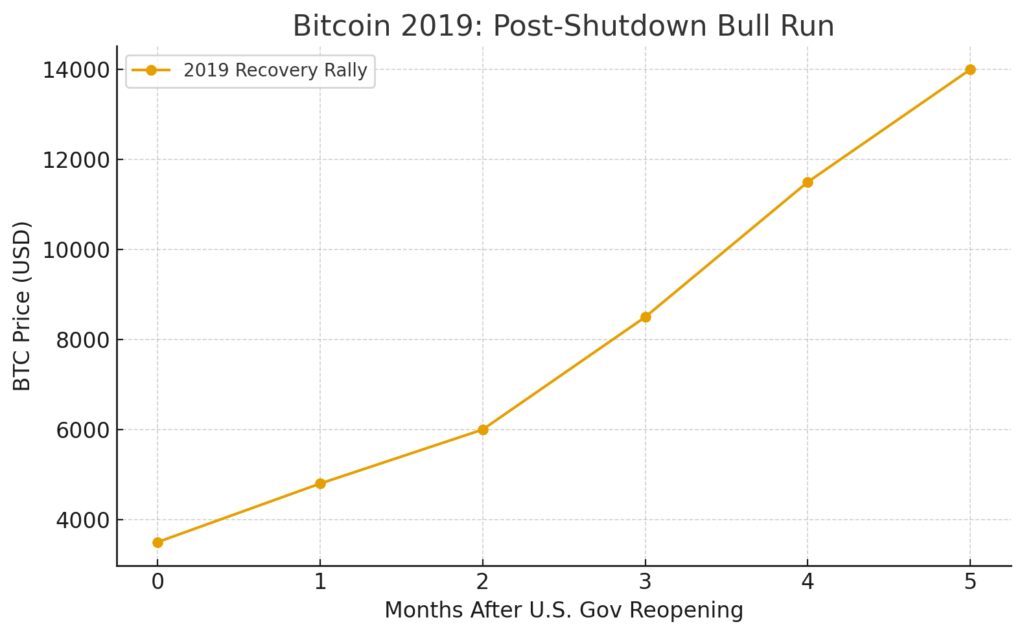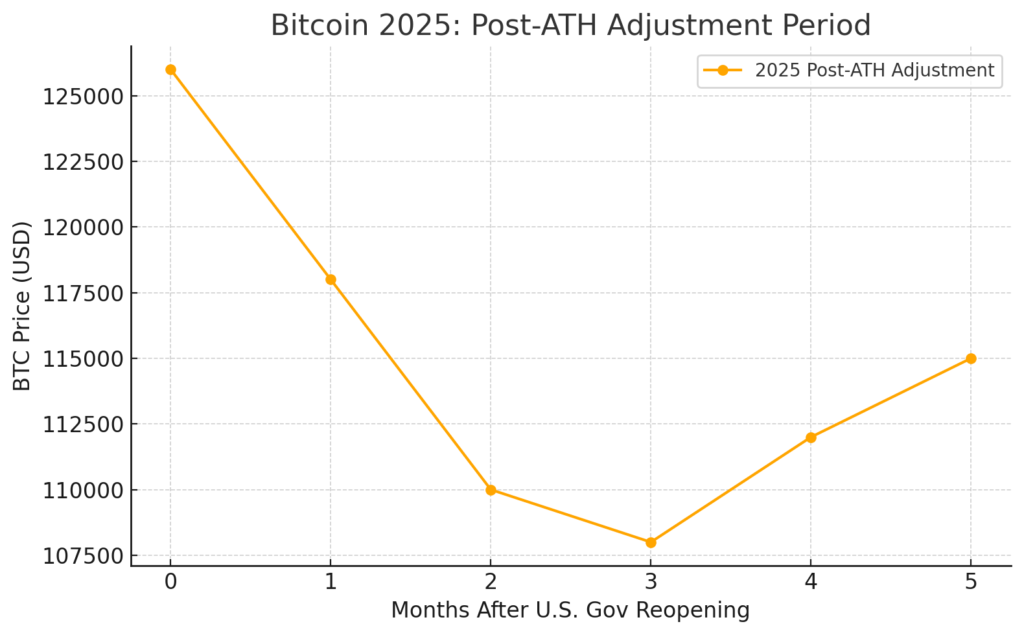
Key Points :
- In 2019, a government-shutdown end coincided with a precipitous bear-market bottom and subsequent rally of Bitcoin (“BTC”) from around US$3,500 to nearly US$14,000 in five months.
- In 2025, BTC is already in the post-all-time-high zone (peak around US$126,200) and the current pull-back is very different in nature.
- Market structure has shifted: spot Bitcoin ETFs exist, institutional adoption is far advanced, and crypto is no longer purely retail speculative.
- Macroeconomic context is different: in 2019, the Federal Reserve moved toward easing; in 2025 inflation remains sticky and easing scope is limited.
- Yet, positive catalyst remains: the end of U.S. government shutdown risk reduces regulatory uncertainty, which could encourage institutional inflows — an upside case for BTC and potentially other new cryptos.
- For new crypto asset hunters, this means the environment is not the same as 2019’s “fast-five-hundred-percent in months” scenario; instead opportunities may lie in derivatives of institutional adoption, protocol innovation, stable-coin/ payments infrastructure, or altcoins that navigate the matured landscape.
1. 2019’s Case: Shutdown Ends + Bear Market Bottom

In early 2019 the U.S. government experienced one of the longest shutdowns in history, and once that risk ended, markets breathed a sigh of relief. For Bitcoin the rally that followed became legendary — from roughly US$3,500 toward nearly US$14,000 in five months.
However, the key driver was not the shutdown per se, but the fact that BTC had just exited a deep bear market (down ~80% from prior highs) and the Fed signalled a shift toward monetary easing. Thus the bullish case rested on a combination of: a market that had bottomed, policy pivot toward liquidity, and investor confidence returning.
In short, 2019 = bear-bottom + easy money + relief event.
2. 2025’s Situation: Already at the Peak and a Different Regime

Contrast that with 2025: BTC reached a record high of approximately US$126,200 on October 6, and the current correction is occurring not from a deep bear market bottom, but from the peak region.
Thus the rally potential is not the same structure as 2019. The market is not in the “bottomed out, waiting for policy pivot” mode — rather it is in a mature cycle where many institutional capital, regulatory clarity, and ETF‐vehicles already exist. The prior rapid “low-to-high” model is less likely to repeat in the same fashion because the foundational conditions differ materially.
3. Structural Market Shift: ETFs, Institutions, Scale
One of the largest changes since 2019 is the degree of institutional integration of Bitcoin. In 2019, Bitcoin ETFs barely existed; by 2025, spot Bitcoin ETFs in the U.S. and globally have accumulated large assets under management. For example, as of mid-July 2025 global AUM in Bitcoin ETFs reached about US$179.5 billion, with U.S. listed funds accounting for roughly US$120 billion.
Another study shows Bitcoin’s correlation with major equity indices (Nasdaq 100, S&P500) rose significantly with institutional adoption, reaching as high as 0.87 in 2024.
From a practical standpoint for new asset hunters, this means: the environment is less “Wild West” speculative and more “institutional finance meets crypto”. Assets that align with institutional frameworks, regulatory compliance, high-quality custody, transparent issuance may fare better.
4. Macroeconomic & Cycle Context: What’s Changed
Several macro and cycle factors differ:
- In 2019 the Fed pivoted toward easing, supporting high risk assets; in 2025 inflation remains elevated, and the Fed’s easing scope is limited.
- The half-life of issuance matters: In 2019, the next Bitcoin halving event was imminent (2020) which often acts as a supply-shock catalyst; in 2025 the next halving (2028) is still ~500+ days away, meaning the half-cycle dynamic is different.
- The investor base: 2019’s rally had heavy retail momentum; in 2025 institutions are more dominant.
These differences imply that the magnitude and speed of a repeat “500% in 5 months” spike are far less probable. The path to growth is likely more nuanced and tied to structural adoption rather than purely speculative momentum.
5. Catalysts Still Exist: Uncertainty Removed & Adoption Lags
Even though the backdrop is not the same as 2019, positive catalysts remain. The news of the U.S. government agency reopening removes a layer of uncertainty and could encourage institutional flows. Moreover regulatory enforcement clarity, stable-coin frameworks, tokenised assets and treasury companies using crypto as reserve are all emerging themes. For example, research shows that in 2025 institutions are increasingly allocating “1-3%” of their portfolios to Bitcoin, mirroring gold-like behaviour.
Another recent point: Treasury companies (corporations holding crypto as primary treasury assets) are proliferating — this institutional ledger shift can create underlying steady demand.
Thus for those seeking new crypto assets or revenue sources, the game is less “catch the rapid rocket” and more “identify protocols and tokens riding institutional infra / regulatory frameworks”.
6. Implications for New Crypto Assets & Blockchain Use Cases
For our audience — those looking for new crypto assets, income opportunities, and blockchain practicalities — what does this all mean?
6.1 Altcoin / Protocol Selection
In a matured market, altcoins will likely succeed if they satisfy:
- compliance with regulation or service to regulated clients (e.g., tokenised real-world assets, institutional settlement).
- integration with institutional infrastructure (custody, ETF-wrappers, treasury management).
- genuine utility (not pure hype) given that speculative open-retail mania is lower.
6.2 Revenue Streams & Use Cases
- Blockchains enabling payments, stable-coins compliant with regulation, tokenised assets (real estate, commodities) may see growth as institutional/legal clarity improves.
- Non-custodial wallet UX (such as your own interest in developing ‘dzilla Wallet’) becomes more critical: bridging retail, DeFi protocols, institutional rails.
- Protocols offering audited, transparent token economics and institutional-grade infrastructure may attract capital even if the “moon-shot” returns are more modest than in 2019.
6.3 Risk/Reward & Timing
- The “easy upside” of a bottomed bear market is gone; instead the upside may be slower, more structural.
- Timing matters: attracting inflows often follows regulatory/structural milestones (ETF launches, policy shifts).
- The ecosystem still faces heightened volatility, regulatory risk, and macro uncertainties despite institutional maturity.
7. Visual Overview: Chart of Bitcoin Cycles

8. Conclusion: Strategy for Investors & Builders
In summary: while the headline “if it rose 290% in 5 months in 2019, it can do so again now” makes for catchy headlines, the reality is materially different in 2025. The market environment is more advanced, institutionalised, and regulated. That doesn’t mean no upside — far from it — but the nature of opportunity now lies in structural adoption and blockchain utility rather than purely speculative leaps.
For those searching for new cryptos and revenue streams: focus on protocols and tokens that align with institutional infrastructure, regulatory clarity, and real-world use cases. Leverage your skills (e.g., in developing non-custodial wallets, token issuance workflows) because the ecosystem now values reliable technology, compliance, and interoperability.
Ultimately, the ratio of risk to reward may be improving for those who enter with discipline, a clear thesis, and focus on the long term—but the “wild ride” investor lottery ticket of 2019 likely isn’t repeating in the same form. Approach with both ambition and realism.

